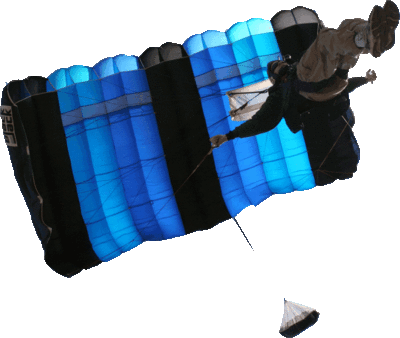Recommended Posts
TomAiello 25
QuoteRather than change grips to 'go to toggles' on a 180 where the object has been avoided through rear riser input.........is it not better to just ease off the amount of rear riser input and still continue the turn until the desired heading is reached....
Or is the altitude loss between riser/toggle turn that different?
In my opinion, it's really that different.
If I have clear air in front of me, I'll let the risers up and pop the toggles.
tommyh 0
Quote
Yeah i climbed down about 50 feet then there was another 50 feet of unclimbable rock down to a ledge that was accessible from the landing area. I sat there for 3 hours while the guy i was jumping with organised some ropes and stuff to get down with (thanks ben!). I was stuck on the face for 4 1/2 hours all up. It ended up being quite fun, after a failed attempt to throw up a rock with some fishing line tied to it, i had to make a rope out of my clothes which came up short, so i made the rest with some bark from a small shrub on the ledge i was on. How not to BASE jump macguyver style...
Cheers,
Jaap
Quote...how in the hell did you get off that ledge?
Some paragliding pilots fly with a roll of dental floss in their harness. That way if they ever land in a tree they can lower the dental floss down to the ground, have someone tie a rope to the end and then they can pull up the rope. Dental floss is light and pretty strong and it is easy to carry 50 yards of it in your pocket.
Any BASE jumpers carry this with them?
leroydb 0
So far, In mine, I include
extra tailgates, diff sized rubber bands, pullup cords, knife, wind meter, closing loops, a small bunch of break cord. 2 links with 2 ft of cord already tied, a small flashlight, gloves unless worn, lighter, DV cable, and a radio if needed for the jump.
believe it or not, this is a "normal" sized waist bag.
What else might I include? I already take a basic load of First Aid equipment for "small" injuries.
Maybe Tom can break this off into a different thread?
..I knew I was an unwanted baby when I saw my bath toys were a toaster and a radio...
460 0
Some of the early jumper commented that whenever their shoes stuck to the wall more than just a moment, the ankles and legs would start breaking and shattering. Friction seems to be an interesting culprit, but I'm just hypothesizing.
LouYoung 0
Quoteextra tailgates, diff sized rubber bands, pullup cords, knife, wind meter, closing loops, a small bunch of break cord. 2 links with 2 ft of cord already tied, a small flashlight, gloves unless worn, lighter, DV cable, and a radio if needed for the jump.
Lockpicks? Black ski mask? Crossbow?


No no ...thats clear enough , thanks
Rather than change grips to 'go to toggles' on a 180 where the object has been avoided through rear riser input.........is it not better to just ease off the amount of rear riser input and still continue the turn until the desired heading is reached....
Or is the altitude loss between riser/toggle turn that different?
Share this post
Link to post
Share on other sites